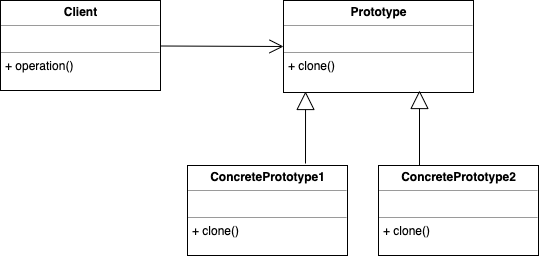생성 - Prototype
Prototype 패턴
생성패턴 중 하나인 프로토타입 패턴은 생성할 객체들의 타입이 프로토타입인 인스턴스로부터 결정되도록 하며, 인스턴스는 새 객체를 만들기 위해 자신을 복제하게 된다.
새로운 객체를 만드는 것이 아니라 Prototype 인스턴스를 복제하는 것이 포인트.

위의 다이어그램을 보면, 클라이언트 코드는 프로토타입의 객체를 복제하여 새로운 객체를 만드려고 하고있다. 프로토타입은 인터페이스(혹은 추상클래스)이고 자신을 복제하는 메소드를 가지고 있다. ConcretePrototype1 과 ConcretePrototype2는 Prototype 인터페이스를 구현하여 clone() 메소드를 가지고 있다.
Prototype 패턴을 사용하는 이유
새로운 객체를 생성하지 않고 복제하는 것이 포인트.
예를 들면 모양과 색이 동일한데 크기나 위치만 다른 객체를 여러 개 만들어야 할 때, 새로운 객체를 생성하는 것 보다 기존의 객체를 복사하여 다른 속성만 변경해주면 클라이언트 코드가 보다 간결해진다.
또 DB에서 가져온 결과를 여러 번 써야하는 경우에 다시 DB에서 같은 쿼리를 실행하지 않고 clone() 메소드를 통해 객체를 복사하여 사용이 가능하기에 리소스를 절약할 수 있다.
예시
앞서 말했던 크기나 위치만 다른 객체를 게임 속 배경에 있는 나무를 예로 들어서 코드로 구현해보겠다.
public abstract class Tree {
// ...
public abstract Tree copy();
}
public class AppleTree extends Tree {
// ...
@Override
public AppleTree copy() {
AppleTree appleTreeClone = new AppleTree(this.getShape(), this.getColor());
appleTreeClone.setHeight(this.getHeight());
return appleTreeClone;
}
}
public class BananaTree extends Tree {
// ...
@Override
public BananaTree copy() {
BananaTree bananaTreeClone = new BananaTree(this.getShape(), this.getColor());
bananaTreeClone.setHeight(this.getHeight());
return bananaTreeClone;
}
}
다이어그램대로 Prototype인 추상클래스 Tree를 만들고 Tree를 상속받는 AppleTree와 BananaTree를 만들었다. 프로토타입 패턴을 적용한 덕분에, concrete class(AppleTree와 BananaTree)에 의존하지 않고(구체 클래스가 뭔지 몰라도) 객체를 복제할 수 있게 되었다.
실제 클라이언트 코드에서 사용하는 예를 보자.
public class TreePrototypeUnitTest{
@Test
public void cloneAppleTree(){
AppleTree appleTree = new AppleTree(shape, color);
appleTree.setHeight(height);
AppleTree anotherAppleTree = (AppleTree) appleTree.copy();
anotherAppleTree.setHeight(height);
assertEquals(height, appleTree.getHeight());
assertEquals(height, appleTree.getHeight());
}
@Test
public void createTreeList() {
AppleTree appleTree = new AppleTree(shape, color);
BananaTree bananaTree = new BananaTree(shape, color);
List<Tree> trees = Arrays.asList(appleTree, bananaTree);
List<Tree> treeClones = trees.stream().map(Tree::copy).collect(toList());
// .....
assertEquals(shape, appleTreeClone.getShape());
assertEquals(color, appleTreeClone.getColor());
}
}
이렇게하여 구체 클래스에 의존하지 않고도 deep copy를 만들어낼 수 있게 되었다.
위의 예시에서는 직접 프로토타입 추상클래스를 만들어 구현하였지만 Java에서는 Cloneable 인터페이스를 implement하여 구현하는 경우가 많다.
단점
다른 패턴들과 마찬가지로 적절한 경우에만 사용해야 한다. 앞서 말했듯, Prototype은 내용이 거의 비슷한 객체를 생성할 때 좋은 패턴이다.
객체를 복제하는 패턴이기 때문에, 클래스가 많으면 프로세스가 복잡해져 코드가 혼잡해질 수 있다. 또 순환 참조가 있는 클래스를 복제하는 것은 어렵다.
의존성이 있는 클래스 두 개가 서로 참조를 하는 것. 애초에 순환 참조는 좋지 않은 구조이기 때문에 풀어내는 것이 바람직하다.
